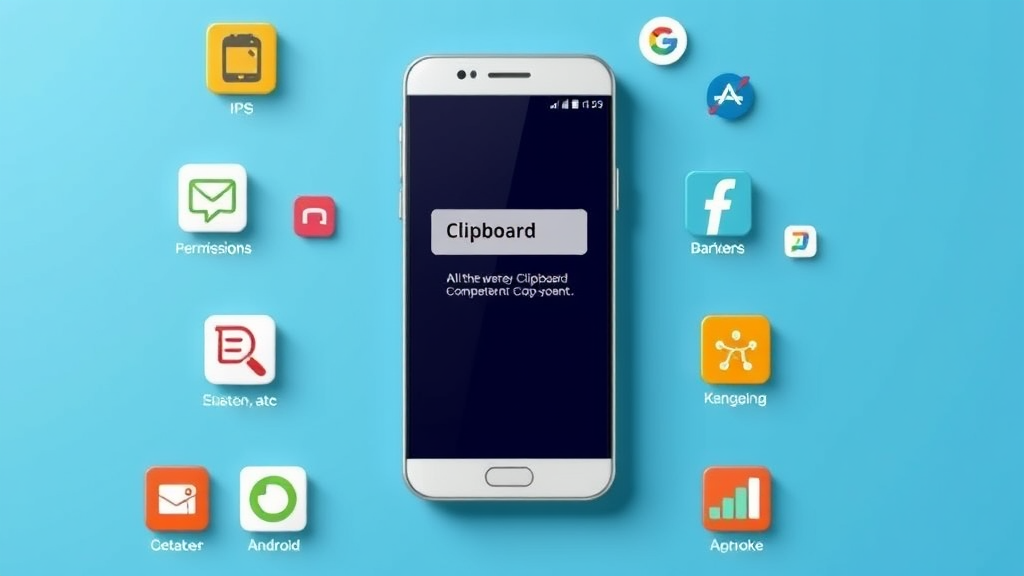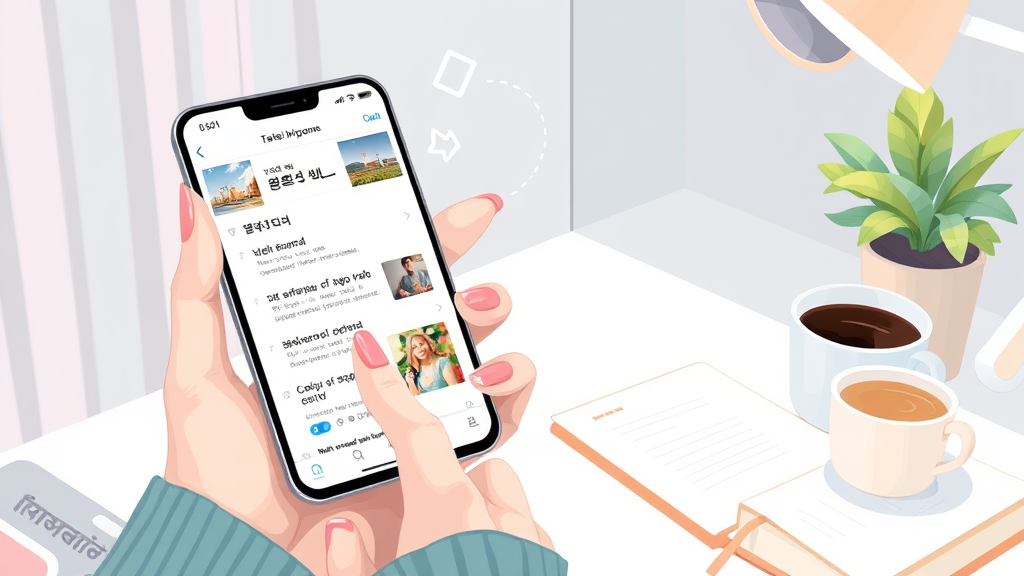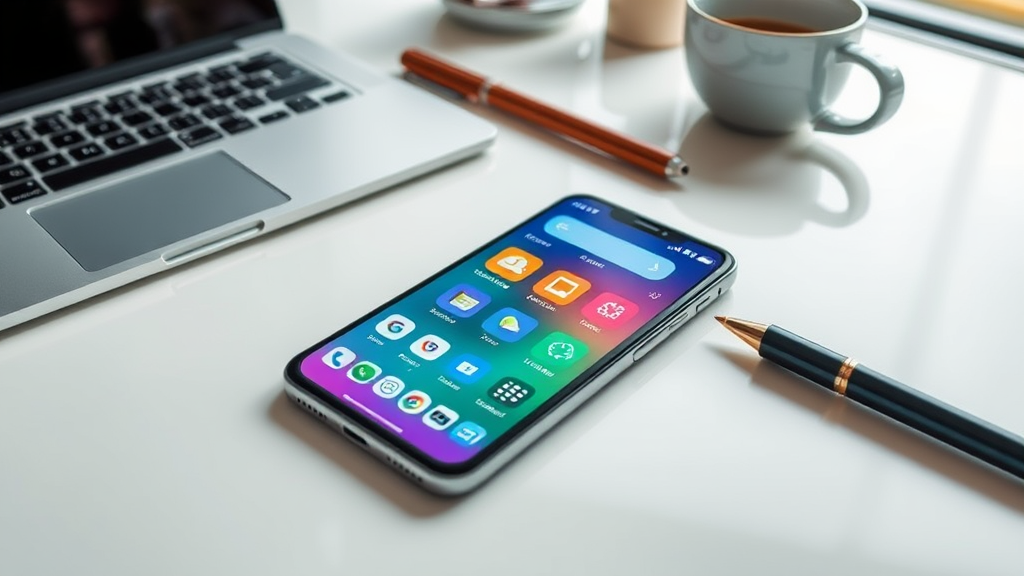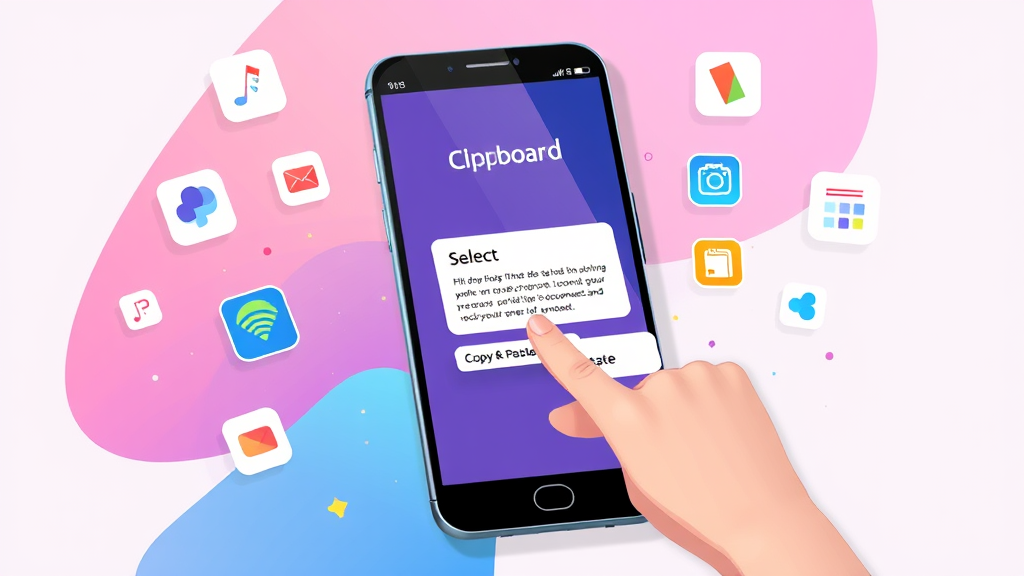
In today’s fast-paced digital world, the ability to quickly share and manage information on our smartphones is more important than ever. One of the most powerful yet often overlooked tools at our disposal is the clipboard feature. Whether you’re copying text from a website, sharing a link in a chat, or jotting down notes, understanding how to effectively use your smartphone’s clipboard can significantly enhance your productivity and streamline your daily tasks. In this comprehensive guide titled “Smartphone Clipboard Usage Guide: Mastering Copy-Paste and Management,” we will explore everything you need to know about utilizing the clipboard on your device. From step-by-step instructions on how to access and use the clipboard, to tips on managing multiple copied items, and insights into clipboard permissions, this guide aims to equip you with the knowledge to master this essential feature. Additionally, we will delve into the differences between clipboard functionalities on Android and iOS, as well as introduce you to third-party clipboard managers that can take your clipboard experience to the next level. Whether you’re a tech novice or an experienced user, this guide will help you unlock the full potential of your smartphone’s clipboard.
How to Use Smartphone Clipboard

The clipboard feature on your smartphone is a powerful tool that allows you to easily copy and paste text, images, and other content between apps. Here’s a step-by-step guide to help you master this functionality.
Accessing the Clipboard
To begin utilizing your smartphone’s clipboard, you first need to understand how to access it. Most modern smartphones come equipped with a clipboard manager that stores copied items temporarily.
- For Android: Generally, when you copy text or images, they are saved to the clipboard automatically. You can access the clipboard by long-pressing in any text field, which will bring up the context menu.
- For iOS: Similar to Android, when you copy something, it is stored in the clipboard. Long-pressing in any text area will also reveal the paste option. However, iOS does not have a dedicated clipboard manager in the same way Android does, but you can still paste your copied content easily.
Copying Text or Images
To copy text or images on your smartphone, follow these steps:
- Locate the content: Open the app or webpage containing the text or image you wish to copy.
- Highlight the content: Tap and hold on the text until you see selection handles. Drag these handles to adjust the selection.
- Copy the content: Once selected, tap ‘Copy’ from the context menu that appears. For images, long-press the image and select ‘Copy’ or ‘Save image’.
Pasting Content
Now that you have copied the desired content, it’s time to paste it into another application:
- Open the target app: Launch the app where you want to paste the copied content (e.g., messaging app, note-taking app, etc.).
- Access a text field: Tap on any text input area where you want the content to appear.
- Paste the content: Long-press in the text field until the context menu appears, then select ‘Paste’. Your copied text or image will now appear in the field.
Managing Clipboard History (Android Only)
Many Android devices offer a clipboard manager that allows you to view and manage your clipboard history. Here’s how to do it:
- Open the clipboard manager by long-pressing in a text field and tapping on the clipboard icon (usually looks like a clipboard or paper).
- Here, you can see all your recently copied items. Tap on any item to paste it instantly.
With these steps, you can effectively use the clipboard on your smartphone, enhancing your productivity and making your tasks easier to manage.
Clipboard Management Tips

Managing your clipboard efficiently can greatly enhance your productivity on your smartphone. Here are some effective strategies for organizing and keeping track of your clipboard content:
1. Utilize Clipboard History Features
Many smartphones come equipped with a clipboard history feature that allows you to access previously copied items. This is particularly useful when you need to retrieve information that you copied earlier but didn’t paste immediately. To enable this feature, check your keyboard settings or download a clipboard manager app from your device’s app store.
2. Organize Your Clipboard Content
When you frequently copy and paste different types of content, it may help to categorize your copied items. For instance, if you often copy text for work, personal notes, and URLs, consider using a clipboard manager app that allows you to tag or categorize these items. This way, you can quickly locate the information you need without sifting through a long list of entries.
3. Clear Clutter Regularly
To avoid clutter in your clipboard, make it a habit to clear out old or unnecessary copied items. Regularly reviewing your clipboard history and deleting items you no longer need will keep it organized and make it easier to find important information. Many clipboard management apps offer the option to delete multiple items at once, saving you time.
4. Use Syncing Features
If you use multiple devices, look for clipboard management apps that offer syncing capabilities. This allows you to access your clipboard history across all your devices, enabling seamless work transitions. For example, if you copy a link on your smartphone, you can easily paste it on your tablet or computer later.
5. Make the Most of Shortcuts
Some smartphones allow you to set up shortcuts for frequently used phrases or pieces of text. This can significantly speed up your workflow, especially if you find yourself typing the same responses or information repeatedly. Check your keyboard settings to see if this feature is available and customize it to suit your needs.
6. Be Mindful of Privacy
Finally, remember that your clipboard may store sensitive information. Always be cautious about what you copy and keep in mind that clipboard managers may retain this data. Make sure to clear sensitive information after use, particularly if you share your device with others or use public devices.
By implementing these clipboard management tips, you can optimize your smartphone usage, making the process of copying and pasting more efficient and organized.
Using Clipboard for Copy-Paste on Smartphones

The clipboard feature on smartphones is an essential tool that enhances productivity by allowing users to copy and paste text across various applications. This guide will walk you through the effective use of the copy and paste functions, covering methods for copying text from different sources and pasting it into your desired apps.
How to Copy Text
Copying text on a smartphone is generally a straightforward process. Here’s how to do it:
- Selecting Text: Tap and hold on the text you want to copy. This action will usually bring up a selection tool with handles that you can drag to adjust the selected portion.
- Copying the Text: Once you have highlighted the desired text, look for an option in the pop-up menu that says “Copy.” Tap this option, and the text will be saved to your clipboard.
- Copying from Different Sources: You can copy text from various sources such as web pages, emails, or documents. The process remains the same—just tap and hold until the selection is made, then choose “Copy.”
How to Paste Text
After copying your text, it’s time to paste it where you need it. Here’s how:
- Open the Desired App: Navigate to the app or field where you want to paste the copied text, such as a messaging app, note-taking app, or document editor.
- Pasting the Text: Tap and hold in the text area until a menu appears. Look for the “Paste” option and tap it. The text from your clipboard will now be inserted into the text field.
Troubleshooting Common Issues
While using the clipboard for copy-paste, you may encounter a few issues. Here are some common problems and their solutions:
- Text Not Copying: Ensure that you are correctly selecting the text and that you are using the “Copy” option from the menu that appears.
- Paste Option Not Available: If you tap and hold in a text area and the “Paste” option does not appear, ensure that you have copied text to the clipboard. You may also try restarting the app or your device.
- Clipboard Data Lost: Some apps may clear the clipboard after closing. If you are using a specific app that does this, consider using a clipboard manager app to retain copied items.
With these steps and troubleshooting tips, you can effectively manage your copy-paste activities on your smartphone, making your tasks more efficient and organized!
Understanding Clipboard Permissions
In today’s digital age, smartphones have become essential tools for daily communication, productivity, and information management. One of the key features that enhance these functions is the clipboard, which allows users to copy and paste text, images, and other data seamlessly. However, with great functionality comes great responsibility, especially when it comes to privacy and security. This is where understanding clipboard permissions becomes crucial.
When you use a clipboard on your smartphone, various apps may request access to it. This access is often necessary for features like text input, quick sharing, or even for app functionalities that rely on data transfer. However, not all apps require clipboard access, and some may misuse this permission if granted. Therefore, it is essential to be aware of what clipboard permissions entail and how to manage them effectively.
What are Clipboard Permissions?
Clipboard permissions allow applications to read from or write to the clipboard on your device. For instance, when you copy a piece of text, it is stored temporarily in the clipboard, and apps that have the right permissions can access this information to provide you with a more streamlined experience. However, this also means that potentially sensitive information, like passwords or personal messages, could be accessed by applications that you may not fully trust.
Privacy Concerns
One of the significant concerns regarding clipboard permissions is privacy. Certain applications, particularly those that are not well-known or have questionable reputations, can monitor clipboard data without your consent. This means that anything you copy—be it a link, sensitive information, or your password—could potentially be accessed by these apps, raising serious security issues.
Managing Clipboard Permissions
To protect your sensitive information and enhance your privacy, it is vital to manage clipboard permissions effectively. Here are some steps you can take:
- Review App Permissions: Check the permissions of the apps installed on your smartphone. You can usually do this in the settings menu under ‘Apps’ or ‘Application Manager.’ Look for any apps that request clipboard access and consider whether they genuinely need this permission.
- Limit Access: Choose to grant clipboard access only to trusted apps. For example, a messaging app may require clipboard access to enable easy sharing of links and images, while a simple game may not need this permission.
- Use Privacy-Focused Apps: Consider using applications known for their strong privacy policies. These apps are less likely to misuse clipboard data and provide better protections for your information.
- Regularly Clear Clipboard: Regularly clear your clipboard to ensure that sensitive information is not stored for longer than necessary. Most smartphones have options to clear the clipboard history, or you can do this manually by copying a non-sensitive piece of text.
By understanding clipboard permissions and actively managing them, you can significantly reduce your risk of privacy breaches while enjoying the convenience that clipboard functionality offers.
Clipboard Features Across Different Operating Systems
Smartphones have revolutionized how we communicate and share information, and the clipboard feature is one of the most essential tools in this process. Both Android and iOS operating systems offer unique clipboard functionalities that cater to different user preferences and needs. Understanding these differences can enhance your experience and efficiency when using your smartphone.
Clipboard Features in Android
Android devices come with a versatile clipboard manager that allows users to copy and paste text, images, and links seamlessly. Here are some key features:
- Rich Content Support: Android’s clipboard supports multiple types of content, including text snippets, images, and even formatted text from apps like Google Docs.
- Clipboard History: Many Android devices come with built-in clipboard history functionality or support third-party apps that enable users to view and manage previously copied items. This allows for easy access to multiple items at once.
- Text Editing Features: Users can edit copied text before pasting, making it easier to customize content according to their needs.
Clipboard Features in iOS
iOS offers a more streamlined clipboard experience, focusing on simplicity and ease of use. Here are the main features:
- Basic Copy-Paste Functionality: iOS provides a straightforward copy-paste feature that works well across various apps, but it is more limited in terms of rich content support compared to Android.
- Universal Clipboard: A standout feature in iOS is the Universal Clipboard, which allows users to copy content on one Apple device and paste it on another, as long as both devices are signed in to the same Apple ID and have Bluetooth and Wi-Fi enabled.
- Limitations: Unlike Android, iOS does not have a built-in clipboard history feature, which can be a drawback for users who need to access multiple copied items frequently.
Maximizing Clipboard Usage
To get the most out of your clipboard on both platforms, consider the following tips:
- Explore Third-Party Apps: For Android users, apps like Clipper or Clipboard Manager can provide enhanced clipboard functionalities, including history tracking and organization.
- Use iCloud for Sharing: iOS users can take advantage of iCloud Drive to save and access documents across devices, complementing the clipboard’s functionality.
- Regularly Clear Your Clipboard: Both Android and iOS users should periodically clear their clipboard to maintain privacy and free up space.
Ultimately, while both Android and iOS provide essential clipboard functionalities, understanding their unique features and limitations allows users to choose the best practices for their specific needs.
Third-Party Clipboard Managers
While the default clipboard functionality on smartphones is sufficient for basic copy-paste tasks, many users find that third-party clipboard managers offer significantly enhanced capabilities. These specialized apps are designed to optimize your clipboard experience, providing a range of features that go beyond the standard functionality.
Benefits of Using Third-Party Clipboard Managers
- Clipboard History: One of the most notable features of third-party clipboard managers is the ability to store clipboard history. This means you can access previously copied items, allowing you to retrieve information without needing to copy it again. This is especially useful for users who frequently copy and paste multiple items.
- Synchronization Across Devices: Many clipboard management apps offer synchronization across multiple devices. This means you can copy text on your smartphone and paste it on your tablet or computer seamlessly. This cross-platform functionality enhances productivity, especially for people who switch between devices regularly.
- Organizational Tools: Third-party clipboard managers often come equipped with organizational features. You can categorize or tag your clipboard items, making it easier to find specific information later. Some apps even allow for search functionality, enabling you to locate items quickly.
- Customization Options: Many clipboard managers allow for customization, such as changing the appearance or layout of the app. This personalization can make the app more user-friendly and align it with your workflow.
- Additional Functionality: Beyond simple copy-paste, some clipboard managers offer additional tools, such as the ability to create notes, share clipboard items directly from the app, and even edit copied text before pasting it.
Popular Third-Party Clipboard Managers
There are numerous clipboard manager apps available for both Android and iOS. Some popular choices include:
- Clipper: Available on Android, Clipper stores a history of your clipboard items and offers powerful organizational features.
- Paste: A popular choice for iOS users, Paste allows for easy synchronization between devices and offers a visually appealing interface.
- ClipStack: This Android app is lightweight but offers essential features for managing clipboard history and organizing copied items.
- Anybuffer: Not only is it a clipboard manager, but it also allows you to store and organize notes, links, images, and more.
In conclusion, third-party clipboard managers can significantly enhance your productivity and streamline your workflow. By leveraging their advanced features, you can master the art of copy-pasting and manage your clipboard more effectively across all your devices.
결론
In conclusion, mastering the smartphone clipboard can significantly enhance your productivity and streamline your daily tasks. By understanding how to effectively use the clipboard, manage its contents, and leverage different features across various operating systems, you can transform the way you copy and paste information on your device. Additionally, being aware of clipboard permissions is crucial for maintaining your privacy and security while using this functionality. For those seeking more advanced capabilities, exploring third-party clipboard managers can further optimize your experience. With the insights from this guide, you are now equipped to utilize your smartphone clipboard to its fullest potential, making your digital interactions smoother and more efficient.